Spring Security 4 Method security using @PreAuthorize,@PostAuthorize, @Secured, EL--转
原文地址:http://websystique.com/spring-security/spring-security-4-method-security-using-preauthorize-postauthorize-secured-el/
In order to enable Spring Method level Security, we need to annotate a @Configuration class with @EnableGlobalMethodSecurity, as shown below:
package com.websystique.springsecurity.configuration;import org.springframework.beans.factory.annotation.Autowired;import org.springframework.context.annotation.Configuration;import org.springframework.security.config.annotation.authentication.builders.AuthenticationManagerBuilder;import org.springframework.security.config.annotation.method.configuration.EnableGlobalMethodSecurity;import org.springframework.security.config.annotation.web.builders.HttpSecurity;import org.springframework.security.config.annotation.web.configuration.EnableWebSecurity;import org.springframework.security.config.annotation.web.configuration.WebSecurityConfigurerAdapter;@Configuration@EnableWebSecurity@EnableGlobalMethodSecurity(prePostEnabled = true)public class SecurityConfiguration extends WebSecurityConfigurerAdapter { @Autowired public void configureGlobalSecurity(AuthenticationManagerBuilder auth) throws Exception { auth.inMemoryAuthentication().withUser("bill").password("abc123").roles("USER"); auth.inMemoryAuthentication().withUser("admin").password("root123").roles("ADMIN"); auth.inMemoryAuthentication().withUser("dba").password("root123").roles("ADMIN","DBA"); } @Override protected void configure(HttpSecurity http) throws Exception { http.authorizeRequests() .antMatchers("/", "/home").access("hasRole('USER') or hasRole('ADMIN') or hasRole('DBA')") .and().formLogin().loginPage("/login") .usernameParameter("ssoId").passwordParameter("password") .and().exceptionHandling().accessDeniedPage("/Access_Denied"); }} |
@EnableGlobalMethodSecurity enables Spring Security global method security similar to the in XML configurations like shown below:
xsi:schemaLocation="http://www.springframework.org/schema/beans http://www.springframework.org/schema/beans/spring-beans-4.1.xsd http://www.springframework.org/schema/security http://www.springframework.org/schema/security/spring-security-4.0.xsd"> <http auto-config="true" > <intercept-url pattern="/" access="hasRole('USER') or hasRole('ADMIN') and hasRole('DBA')" /> <intercept-url pattern="/home" access="hasRole('USER') or hasRole('ADMIN') and hasRole('DBA')" /> <form-login login-page="/login" username-parameter="ssoId" password-parameter="password" authentication-failure-url="/Access_Denied" /> </http> <global-method-security pre-post-annotations="enabled"/> <authentication-manager > <authentication-provider> <user-service> <user name="bill" password="abc123" authorities="ROLE_USER" /> <user name="admin" password="root123" authorities="ROLE_ADMIN" /> <user name="dba" password="root123" authorities="ROLE_ADMIN,ROLE_DBA" /> </user-service> </authentication-provider> </authentication-manager> </beans:beans> |
Note that @EnableGlobalMethodSecurity can take several arguments, some are shown below:
- prePostEnabled :Determines if Spring Security’s pre post annotations [@PreAuthorize,@PostAuthorize,..] should be enabled.
- secureEnabled : Determines if Spring Security’s secured annotation [@Secured] should be enabled.
- jsr250Enabled : Determines if JSR-250 annotations [@RolesAllowed..] should be enabled.
You can enable more than one type of annotation in the same application, but only one type should be used for any interface or class as the behavior will not be well-defined otherwise. If two annotations are found which apply to a particular method, then only one of them will be applied.
We will explore first two of above mentioned in detail.
@Secured
@Secured annotation is used to define a list of security configuration attributes for business methods. You can specify the security requirements[roles/permission etc] on a method using @Secured, and than only the user with those roles/permissions can invoke that method. If anyone tries to invoke a method and does not possess the required roles/permissions, an AccessDenied exception will be thrown.
@Secured is coming from previous versions of Spring. It has a limitation that it does not support Spring EL expressions. Consider following example:
package com.websystique.springsecurity.service;import org.springframework.security.access.annotation.Secured;public interface UserService { List<User> findAllUsers(); @Secured("ROLE_ADMIN") void updateUser(User user); @Secured({ "ROLE_DBA", "ROLE_ADMIN" }) void deleteUser(); } |
In above example, updateUser method can be invoked by someone with ADMIN role while deleteUser can be invoked by anyone with DBA OR ADMIN role. If anyone tries to invoke a method and does not possess the required role, an AccessDenied exception will be thrown.
What if you want to specify an ‘AND’ condition. I mean , you want deleteUser method to be invoked by a user who have both ADMIN & DBA role. This is not possible straight-away with @Secured annotation.
This can however be done using Spring’s new @PreAuthorize/@PostAuthorize annotations which supports Spring EL, that means possibilities are unlimited.
@PreAuthorize / @PostAuthorize
Spring’s @PreAuthorize/@PostAuthorize annotations are preferred way for applying method-level security, and supports Spring Expression Language out of the box, and provide expression-based access control.
@PreAuthorize is suitable for verifying authorization before entering into method. @PreAuthorize can take into account, the roles/permissions of logged-in User, argument passed to the method etc.
@PostAuthorize , not often used though, checks for authorization after method have been executed, so it is suitable for verifying authorization on returned values. Spring EL provides returnObject object that can be accessed in expression language and reflects the actual object returned from method.
Please refer to Common Built-In Expressions to get the complete list of supported expressions.
Let’s get back to our example, this time using @PreAuthorize / @PostAuthorize.
package com.websystique.springsecurity.service;import org.springframework.security.access.prepost.PostAuthorize;import org.springframework.security.access.prepost.PreAuthorize;import com.websystique.springsecurity.model.User;public interface UserService { List<User> findAllUsers(); @PostAuthorize ("returnObject.type == authentication.name") User findById(int id); @PreAuthorize("hasRole('ADMIN')") void updateUser(User user); @PreAuthorize("hasRole('ADMIN') AND hasRole('DBA')") void deleteUser(int id);} |
Since @PreAuthorize can use Spring Expression Language, any condition can easily be expressed using EL. Method deleteUser is now configured to be invoked by a user who have both ADMIN & DBA roles.
Additionally, we have added a method findById() with @PostAuthorize annotation. With @PostAuthorize, the returned value from the method(User object) will be accessible with returnObject in Spring Expression Language, and individual properties of return user object can be used to apply some security rules. In this example we are making sure that a logged-in user can only get it’s own User type object.
That’s all about basic usage of @Secured, @PreAuthorize, @PostAuthorize and EL.
Below mentioned is service implementation, User model class & Controller, used in this example.
package com.websystique.springsecurity.service;import java.util.ArrayList;import java.util.List;import org.springframework.stereotype.Service;import org.springframework.transaction.annotation.Transactional;import com.websystique.springsecurity.model.User;@Service("userService")@Transactionalpublic class UserServiceImpl implements UserService{ static List<User> users = new ArrayList<User>(); static{ users = populateUser(); } public List<User> findAllUsers(){ return users; } public User findById(int id){ for(User u : users){ if(u.getId()==id){ return u; } } return null; } public void updateUser(User user) { System.out.println("Only an Admin can Update a User"); User u = findById(user.getId()); users.remove(u); u.setFirstName(user.getFirstName()); u.setLastName(user.getLastName()); u.setType(user.getType()); users.add(u); } public void deleteUser(int id){ User u = findById(id); users.remove(u); } private static List<User> populateUser(){ List<User> users = new ArrayList<User>(); users.add(new User(1,"Sam","Disilva","admin")); users.add(new User(2,"Kevin","Brayn","admin")); users.add(new User(3,"Nina","Conor","dba")); users.add(new User(4,"Tito","Menz","dba")); return users; }} |
public class User { private int id; private String firstName; private String lastName; private String type;//getters/setters} |
package com.websystique.springsecurity.controller;import java.util.List;import javax.servlet.http.HttpServletRequest;import javax.servlet.http.HttpServletResponse;import org.springframework.beans.factory.annotation.Autowired;import org.springframework.security.core.Authentication;import org.springframework.security.core.context.SecurityContextHolder;import org.springframework.security.core.userdetails.UserDetails;import org.springframework.security.web.authentication.logout.SecurityContextLogoutHandler;import org.springframework.stereotype.Controller;import org.springframework.ui.ModelMap;import org.springframework.web.bind.annotation.PathVariable;import org.springframework.web.bind.annotation.RequestMapping;import org.springframework.web.bind.annotation.RequestMethod;import com.websystique.springsecurity.model.User;import com.websystique.springsecurity.service.UserService;@Controllerpublic class HelloWorldController { @Autowired UserService service; @RequestMapping(value = { "/", "/list" }, method = RequestMethod.GET) public String listAllUsers(ModelMap model) { List<User> users = service.findAllUsers(); model.addAttribute("users", users); return "allusers"; } @RequestMapping(value = { "/edit-user-{id}" }, method = RequestMethod.GET) public String editUser(@PathVariable int id, ModelMap model) { User user = service.findById(id); model.addAttribute("user", user); model.addAttribute("edit", true); return "registration"; } @RequestMapping(value = { "/edit-user-{id}" }, method = RequestMethod.POST) public String updateUser(User user, ModelMap model, @PathVariable int id) { service.updateUser(user); model.addAttribute("success", "User " + user.getFirstName() + " updated successfully"); return "success"; } @RequestMapping(value = { "/delete-user-{id}" }, method = RequestMethod.GET) public String deleteUser(@PathVariable int id) { service.deleteUser(id); return "redirect:/list"; } @RequestMapping(value = "/Access_Denied", method = RequestMethod.GET) public String accessDeniedPage(ModelMap model) { model.addAttribute("user", getPrincipal()); return "accessDenied"; } @RequestMapping(value = "/login", method = RequestMethod.GET) public String loginPage() { return "login"; } @RequestMapping(value="/logout", method = RequestMethod.GET) public String logoutPage (HttpServletRequest request, HttpServletResponse response) { Authentication auth = SecurityContextHolder.getContext().getAuthentication(); if (auth != null){ new SecurityContextLogoutHandler().logout(request, response, auth); } return "redirect:/login?logout"; } private String getPrincipal(){ String userName = null; Object principal = SecurityContextHolder.getContext().getAuthentication().getPrincipal(); if (principal instanceof UserDetails) { userName = ((UserDetails)principal).getUsername(); } else { userName = principal.toString(); } return userName; }} |
Complete code for this example is attached at the end of this post.
Deploy & Run
Download complete code example attached at the end of post. Deploy it on Servlet 3.0 container(Tomcat 8.0.21 e.g.).
Open browser and goto http://localhost:8080/SpringSecurityMethodLevelSecurityAnnotationExample/, you will be prompted for login. Fill in USER role credentials.
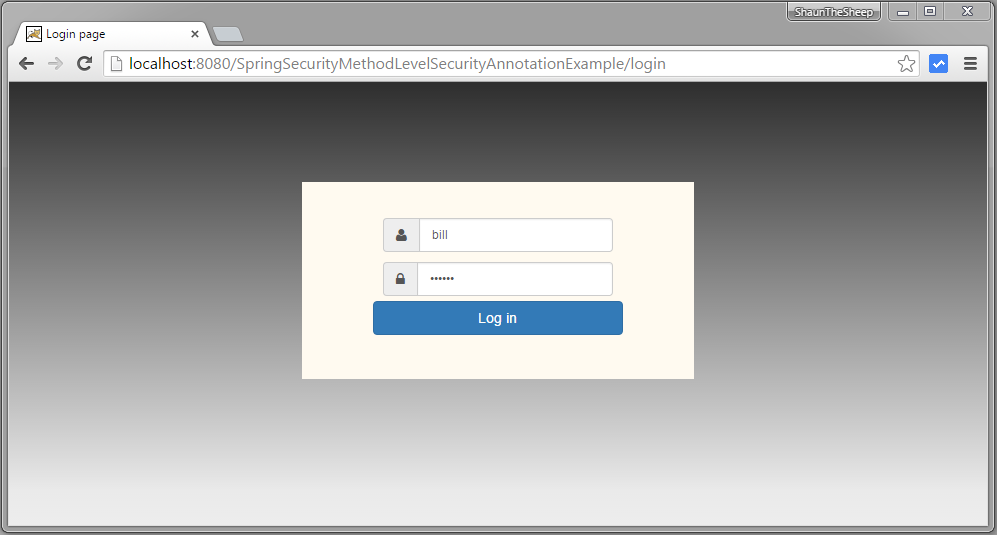
Submit, you will see list of users.
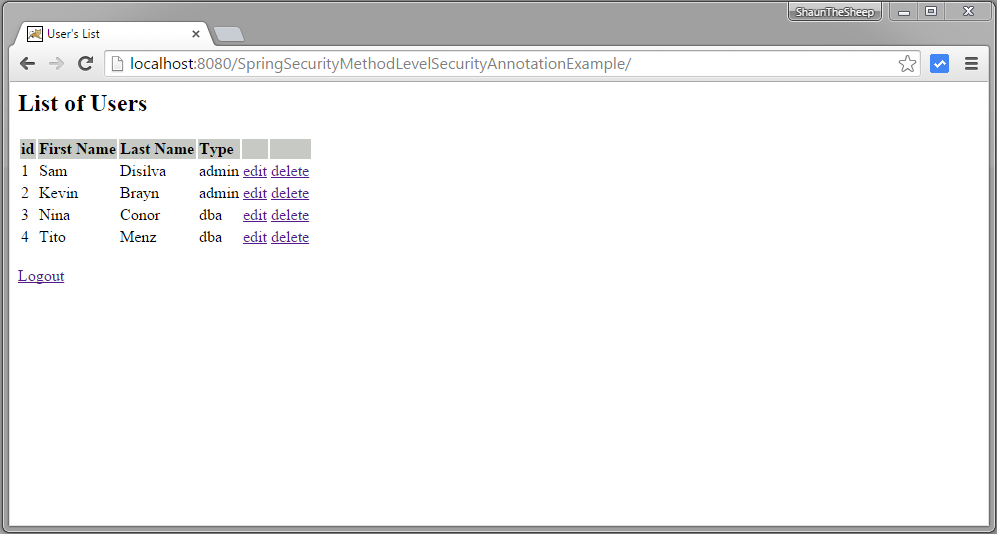
Now try to edit or delete a users, you should see accessDenied page, because USER role does not have access to these functions.
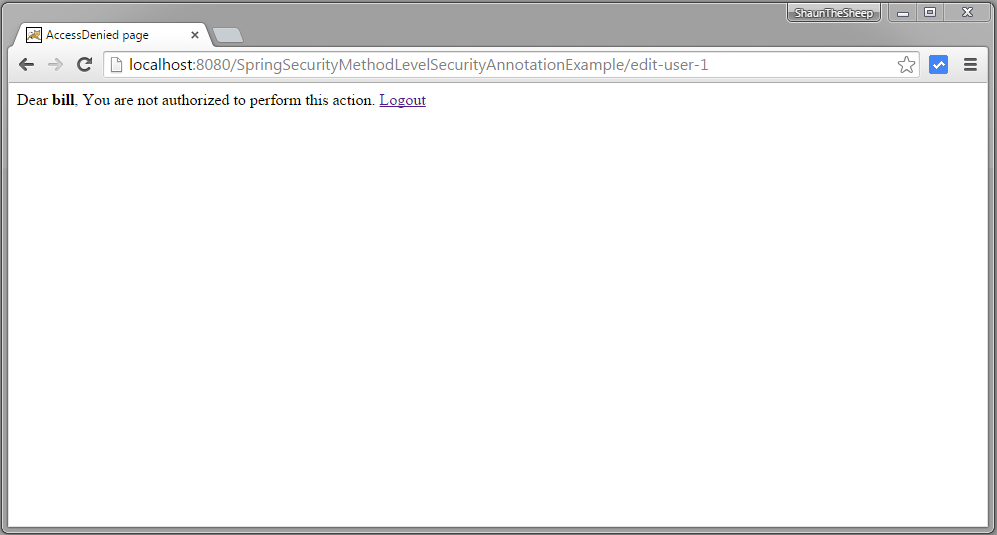
Logout. Login with ADMIN role credentials.
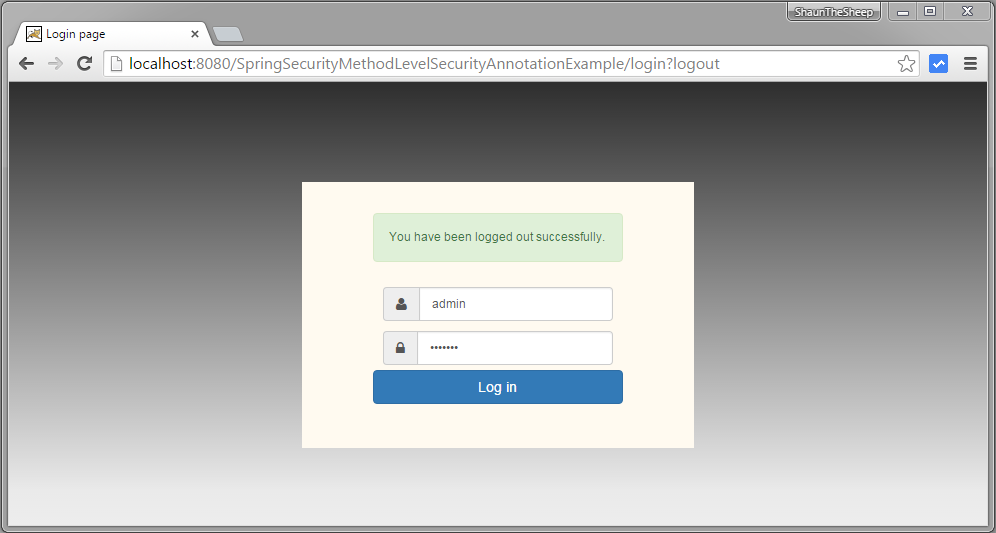
Submit, you will see list of users.

Now click on edit for first row [with type='admin']. Edit page should be presented.
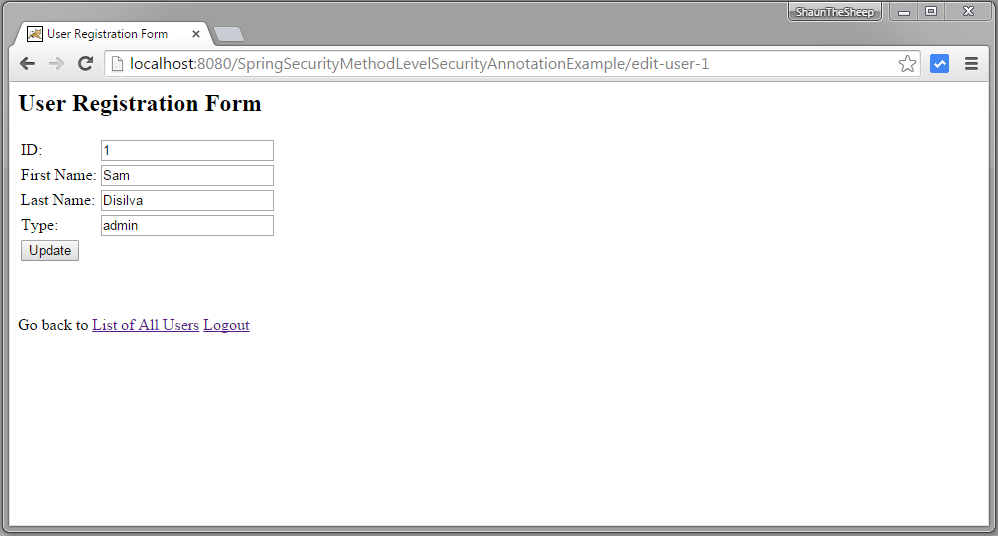
Now go back to list of item and click on third row [with type = 'dba']
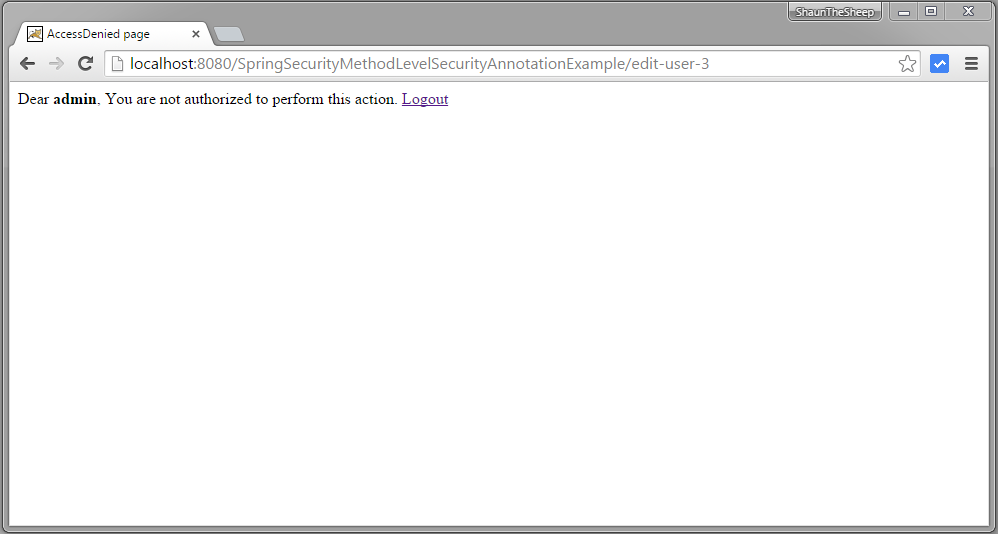
You got accessDenied because during edit, function findById gets called which is annotated with @PostAuthorize annotation with EL restricting the returned object to be only with type['dba'] same as logged-in user name.
Now click on any delete row, accessDenied should be shown as deleteUser is only allowed for role ‘DBA’.
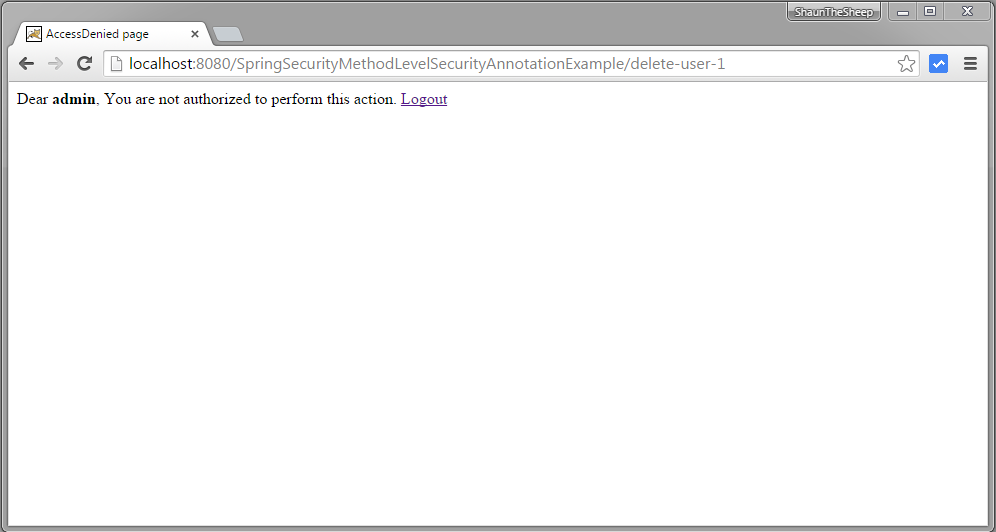
Now logout, login with DBA role [dba,root123], and click on delete link of first row. Row should be deleted successfully.
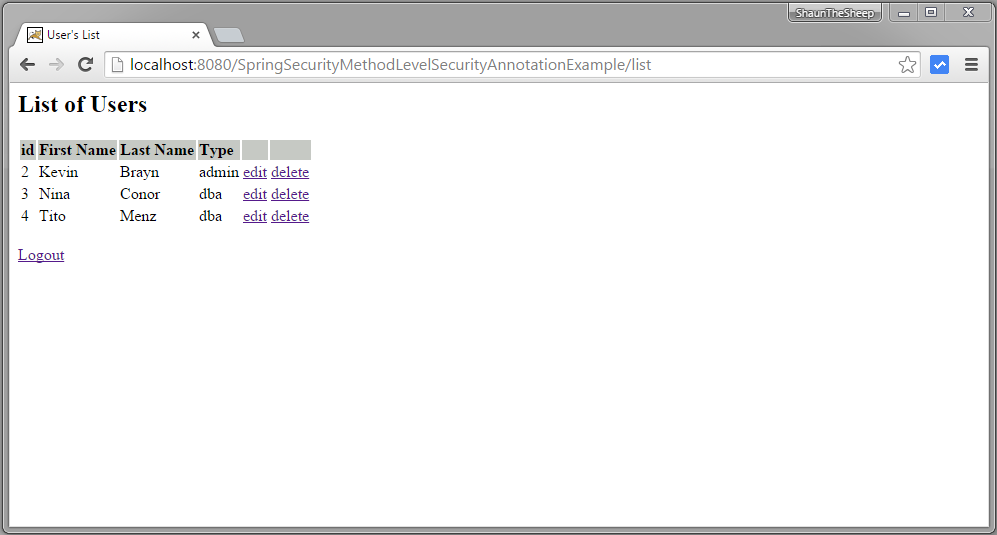
That’s it.
Spring Security 4 Method security using @PreAuthorize,@PostAuthorize, @Secured, EL--转的更多相关文章
- Spring Security 4 使用@PreAuthorize,@PostAuthorize, @Secured, EL实现方法安全
[相关已翻译的本系列其他文章,点击分类里面的spring security 4] 上一篇:Spring Security 4 整合Hibernate 实现持久化登录验证(带源码) 原文地址:http: ...
- Security注解:@PreAuthorize,@PostAuthorize, @Secured, EL实现方法安全
说明 (1)JDK版本:1.8(2)Spring Boot 2.0.6(3)Spring Security 5.0.9(4)Spring Data JPA 2.0.11.RELEASE(5)hibe ...
- spring security method security
参考 Spring Security 官方文档 http://www.concretepage.com/spring/spring-security/preauthorize-postauthoriz ...
- Java Spring Boot VS .NetCore (九) Spring Security vs .NetCore Security
Java Spring Boot VS .NetCore (一)来一个简单的 Hello World Java Spring Boot VS .NetCore (二)实现一个过滤器Filter Jav ...
- java.security.ProviderException: java.security.KeyException
本机部署没问题,部署到linux服务器报错: javax.net.ssl.SSLException: java.security.ProviderException: java.security.Ke ...
- 记CM+kerberos环境停电后无法启动报错An error: (java.security.PrivilegedActionException: javax.security.sasl.SaslException: GSS initiate failed [Caused by GSSException: No valid credentials provided (Mechanism leve
公司突然停电,然后cm环境无法重启,报错 An error: (java.security.PrivilegedActionException: javax.security.sasl.SaslExc ...
- Spring Security(二十二):6.4 Method Security
From version 2.0 onwards Spring Security has improved support substantially for adding security to y ...
- Spring Security(十七):5.8 Method Security
From version 2.0 onwards Spring Security has improved support substantially for adding security to y ...
- 41.4 Method Security方法安全性
41.4.1 <global-method-security> 这个元素是为Spring Security beans上的安全方法添加支持的主要手段.可以通过使用注释(在接口或类级别定义) ...
随机推荐
- UVA 11248 Frequency Hopping
Frequency Hopping Time Limit: 10000ms Memory Limit: 131072KB This problem will be judged on UVA. Ori ...
- List Slider
http://www.jssor.com/download-jssor-slider-development-kit.html
- 尼克的任务 dp 洛谷1280
蒟蒻表示老久没看过dp题目了,,挺水的一道dp题目都没想出来,,, 首先设dp[i]表示从开始到i时间的最大空闲时间,用vector to[x] 表示从x点开始的任务结束时间,cnt[x]表示从x开始 ...
- UVA 11020 Efficient Solutions+multiset的应用
题目链接:点击进入 首先来讲,非常easy看到我们事实上仅仅要维护优势人群的集合:假设增加一个新的人,我们首先看一下优势人群中是否有人会让这个人失去优势,假设没有,则将这个人插入集合中.但要注意到这个 ...
- hdoj Let the Balloon Rise
/*Let the Balloon Rise Problem Description Contest time again! How excited it is to see balloons ...
- 去除ListView 上下边界蓝色或黄色阴影
默认的情况下,在 ListView 滑动到顶部或者是底部的时候,会有黄色或者蓝色的阴影出现.在不同的版本号上解决办法是不同的,在 2.3 版本号之前能够在 ListView 的属性中通过设置 andr ...
- thinkphp5项目--个人博客(四)
thinkphp5项目--个人博客(四) 项目地址 fry404006308/personalBlog: personalBloghttps://github.com/fry404006308/per ...
- Metasploit学习笔记(博主推荐)
不多说,直接上干货! 连接后台的数据库,当然不是必须品. 连接数据库的好处:1.可以攻击和扫描的结果,保存起来 2.将一些搜索结果做个缓存 默认数据库是postgresql. 同时要注意的是 ...
- HDFS的配额
- Lua,github,nginx
个人觉得这几种工具都是大学里,至少是前几年未曾出现于课本中或者图书馆中的.而如今确实某些公司赫然出现在招聘需求中的东西. 什么是Lua,为什么要用Lua——做手机游戏而被推广的.Lua原来早在93年就 ...
